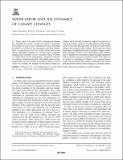Water vapor and the dynamics of climate changes
Author(s)
Schneider, Tapio; Levine, Xavier J.; O'Gorman, Paul
Downloadschneider_water_vapor_dynamics_review_2010.pdf (5.333Mb)
PUBLISHER_POLICY
Publisher Policy
Article is made available in accordance with the publisher's policy and may be subject to US copyright law. Please refer to the publisher's site for terms of use.
Terms of use
Metadata
Show full item recordAbstract
Water vapor is not only Earth's dominant greenhouse gas. Through the release of latent heat when it condenses, it also plays an active role in dynamic processes that shape the global circulation of the atmosphere and thus climate. Here we present an overview of how latent heat release affects atmosphere dynamics in a broad range of climates, ranging from extremely cold to extremely warm. Contrary to widely held beliefs, atmospheric circulation statistics can change nonmonotonically with global-mean surface temperature, in part because of dynamic effects of water vapor. For example, the strengths of the tropical Hadley circulation and of zonally asymmetric tropical circulations, as well as the kinetic energy of extratropical baroclinic eddies, can be lower than they presently are both in much warmer climates and in much colder climates. We discuss how latent heat release is implicated in such circulation changes, particularly through its effect on the atmospheric static stability, and we illustrate the circulation changes through simulations with an idealized general circulation model. This allows us to explore a continuum of climates, to constrain macroscopic laws governing this climatic continuum, and to place past and possible future climate changes in a broader context.
Date issued
2010-07Department
Massachusetts Institute of Technology. Department of Earth, Atmospheric, and Planetary SciencesJournal
Reviews of Geophysics
Publisher
American Geophysical Union
Citation
Schneider, Tapio, Paul A. O’Gorman, and Xavier J. Levine. “Water Vapor and the Dynamics of Climate Changes.” Reviews of Geophysics 48.3 (2010) : n. pag. Copyright 2010 by the American Geophysical Union.
Version: Final published version
ISSN
8755-1209